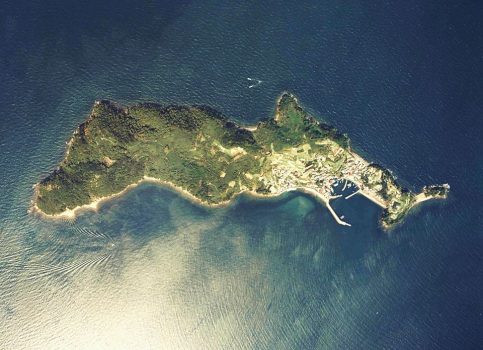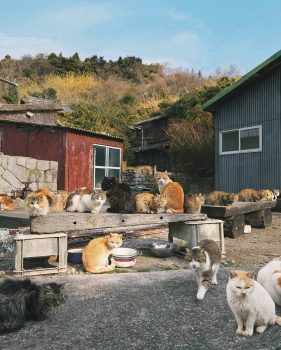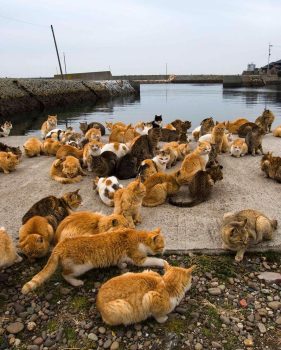 Pin
Pin Copyright © National Land Image Information (Color Aerial Photographs), Ministry of Land, Infrastructure, Transport and Tourism, Attribution, via Wikimedia Commons
In the southern part of Japan, off the coast of Ehime Prefecture, lies a tiny island unlike any other. It’s called Aoshima, but most people know it by a different name—Cat Island in Japan. Here, cats roam the streets, docks, and rooftops, living freely among the island’s few remaining human residents. It’s not a man-made tourist attraction or a promotional gimmick—it’s real life. A place where felines outnumber people, where boats bring curious travelers once or twice a day, and where quietness rules.
While other destinations boast flashy signs and packed itineraries, Aoshima offers something more unusual: stillness. There’s no rush, no schedule, no loud distractions—just the soft shuffle of paws, the sound of ocean waves, and a peaceful rhythm that feels almost forgotten in today’s world. The story of Aoshima isn’t just about cats. It’s about what happens when humans step back, and nature takes over—not with wild chaos, but with calm presence. Let’s explore what makes this island so unexpectedly powerful.
Table of Contents
Aoshima—A Quiet Fishing Village Turned Cat Kingdom
 Pin
Pin Image by Thomas Peter
In the Ehime Prefecture of Japan lies a small island called Aoshima, part of Ozu City. Known now as the famous cat island in Japan, Aoshima wasn’t always this way. Originally a peaceful fishing village, its population has declined sharply over the years, leaving behind only a few elderly residents. But it’s the cats that truly stayed and multiplied. With fewer humans around, these felines started taking over abandoned homes, piers, and narrow paths. What makes Aoshima stand out isn’t just the number of cats—it’s how naturally they’ve blended into the environment. They aren’t shy or aggressive; they simply live as if the island belongs to them. And in many ways, it does. Visitors stepping off the boat are immediately greeted by dozens of curious feline faces, strolling confidently like they run the show. This unexpected balance between nature, abandoned human structures, and freely roaming cats creates an almost surreal atmosphere that pulls in animal lovers from around the world.
How Did So Many Cats End Up on One Island?
 Pin
Pin Image by Thomas Peter
The story behind Aoshima’s feline explosion is surprisingly down-to-earth. Decades ago, fishermen brought cats to the island to deal with mice that infested their boats and storage areas. It made perfect sense at the time—cats were natural pest control. But as fishing activity slowed and people moved away for jobs in cities, the cats stayed behind. With no natural predators and plenty of space, their population quietly grew. Unlike urban stray cats, the ones on Aoshima weren’t driven by hunger or survival. They roamed freely and multiplied in peace. Residents didn’t spay or neuter them, partly due to lack of access and partly because they never expected the numbers to rise so fast. Before long, the cats outnumbered humans six to one. With fewer than a dozen people living there now, the cats are essentially the main inhabitants. This isn’t some tourist ploy or media stunt—it’s a real story of nature adapting to human changes in the most unexpected way.
What It's Like to Visit Aoshima Today
 Pin
Pin Image by Itsuka Japan/ Youtube
Stepping onto Aoshima feels like entering a parallel world—one where cats casually lounge in boats, nap under trees, and stroll along narrow paths with the ease of royalty. There are no shops, no restaurants, not even vending machines. The island isn’t built for tourists. But that’s part of its charm. Visitors arrive by a small ferry that runs twice a day from Nagahama Port, and that’s it—once you’re there, it’s just you, the sea breeze, and dozens of cats. Most are friendly, though some are reserved, keeping their distance. Tourists often bring cat food, but feeding is discouraged unless it’s approved by locals. The island is quiet, peaceful, and strangely meditative. There’s something calming about watching cats go about their lives, unbothered by the rush of modern life. It’s not a commercial attraction—it’s a slice of real life that just happens to be filled with cats. For many, it’s a once-in-a-lifetime experience, more spiritual than scenic.
The Role of Elderly Residents in Cat Care
Though only a few people still live on Aoshima, their presence is crucial. These elderly residents, mostly in their 70s and 80s, share a quiet companionship with the cats. Over time, they’ve formed a mutual rhythm—feeding, caring, and coexisting. There’s no formal animal shelter or organized rescue group here. Instead, it’s the hands of these older islanders that keep the balance. They leave food out, keep an eye on sick or injured cats, and even build makeshift shelters using cardboard, wood, and leftover materials. Their relationship with the cats isn’t sentimental or overly affectionate. It’s practical, respectful, and shaped by daily life. These residents rarely speak of the cats as “pets.” Instead, they see them as fellow islanders. In a world that’s rapidly modernizing, Aoshima holds onto a kind of slow-living harmony. The elderly care for the cats without fuss, and in return, the cats bring a sense of presence and purpose to their routine days. It’s quiet but deeply meaningful.
Why Aoshima Isn’t a Tourist Hotspot (and That’s a Good Thing)
Despite being known globally as a cat island, Aoshima hasn’t turned into a commercial tourist hub. There are no souvenir shops or themed cafes. Most visitors are surprised by how little infrastructure there is. That’s intentional. The island’s residents have made it clear—they don’t want Aoshima to be overrun by crowds. The ferry only allows a limited number of passengers per day, and there’s no overnight accommodation on the island. This keeps the balance intact. Too much attention could stress the cats and disrupt the natural pace of life. Visitors who do make the trip often say it feels more like a pilgrimage than a vacation. It’s about quiet observation, not entertainment. You sit on a bench, surrounded by cats, and just… exist. For people used to rushed city life or crowded tourist sites, that simplicity hits differently. Aoshima’s refusal to become commercial is part of what makes it feel authentic. It’s an unpolished gem, and that’s why it sticks in your memory.
The Unique Behavior of Aoshima’s Feline Residents
Cats on Aoshima aren’t like street cats you find in cities. Over time, their behavior has adapted to the island’s peaceful environment. They’re used to seeing people, but they’re not demanding or aggressive. They approach slowly, curiously, and often wait for you to sit before making contact. They don’t fight for food or space like urban strays might. Instead, they nap in groups, share shaded spots, and live with an unspoken order among them. Some cats form little cliques, sticking to certain parts of the island—like the pier group, the hill group, or the boat group. Others roam freely between zones. Observing them gives insight into feline social patterns when they’re not pressured by survival. Since there’s minimal traffic and noise, cats often lie in the middle of pathways, stretched out as if they own the place—which, to be honest, they kind of do. Visitors often note how relaxed and healthy many of them seem, as if island life has made them calm and content.
Challenges Facing Aoshima and Its Cats
Aoshima might look like a cat paradise, but it’s not without problems. The biggest concern is overpopulation. With limited resources and no formal veterinary care on the island, controlling the number of cats has become difficult. While some efforts have been made to spay and neuter the cats—mostly through volunteers and animal welfare groups—they haven’t been consistent enough to slow the growth effectively. Another issue is sustainability. The few elderly residents can’t care for the cats forever, and there’s no younger generation stepping in to take over. Food donations from visitors help, but they’re not always reliable or properly balanced. In the long run, the island might not be able to support such a large feline population without external help. The cats live peacefully now, but their future depends on better care systems and cooperation between locals and outside groups. Aoshima is beautiful, but keeping it that way will require attention and effort that’s currently stretched thin.
How the World Found Out About Cat Island
For a long time, Aoshima was just a name on a map. Things changed when photos and videos of the island’s cats began appearing online. A few tourists shared pictures of being surrounded by cats, and suddenly, the internet took notice. Viral posts on Reddit, Twitter, and travel blogs made the term cat island in Japan spread fast. People were fascinated by a place where cats outnumber humans. Unlike the usual glossy travel content, these photos were raw—cats sprawled across docks, curled up in boats, sunbathing on window sills. The charm was in its simplicity. No filters, no fancy tourist spots—just cats living freely. News outlets picked up the story, and YouTube channels followed with travel vlogs and documentaries. Interest exploded. But while this brought attention, it also raised concerns. The sudden wave of visitors led to calls for responsible tourism. Awareness brought help, but also pressure. The spotlight made Aoshima a symbol—not just of cuteness, but of the delicate line between exposure and preservation.
Responsible Tourism—What Visitors Should Know Before Going
Visiting Aoshima isn’t like a typical day trip. There’s a quiet respect that surrounds the island, and visitors are expected to follow it. First, there are no shops or toilets on the island—none. Bring everything you need, including water and supplies, but keep your belongings tidy. Second, avoid feeding the cats unless you’ve been given permission or guidance by residents. Random feeding can upset their diet or cause health issues. It’s also important not to pick up or force interaction with the cats. Let them come to you. Many of them are friendly, but they’re still animals with boundaries. Don’t leave trash, don’t bring loud devices, and absolutely don’t treat the island like a photo prop. The people here live quietly, and the cats thrive in that calm. Visitors should aim to preserve that atmosphere. It’s not a theme park—it’s a living, breathing community. Being mindful of your presence means helping protect what makes Aoshima feel so rare and special in the first place.
Aoshima’s Legacy
Aoshima may be known as a cat island, but its legacy stretches beyond cute photos and viral fame. It represents something deeper—a quiet rebellion against fast-paced modern life. In a country where cities are packed with bullet trains and high-tech living, Aoshima slows everything down. It reminds people what happens when nature and simplicity take the lead. The island isn’t trying to impress anyone. It’s just doing what it’s always done—existing, gently. For animal lovers, Aoshima becomes more than a travel destination; it’s an emotional experience. It leaves a mark not through spectacle, but through stillness. Even after you leave, the image of cats lazily sunbathing near the ocean lingers in your mind. You start to value silence more, appreciate soft things, and feel a bit lighter. The story of Aoshima is also about people—those who stayed behind, those who care quietly, and those who visit respectfully. In its own way, the island teaches empathy, balance, and the strange magic of being present.
FAQs
To reach Aoshima, you’ll need to travel to Nagahama Port in Ozu, Ehime Prefecture. From there, a ferry departs twice a day to Aoshima. Be sure to check the schedule ahead of time because seats are limited and there are no additional trips if the boat fills up. Also, there are no accommodations on the island, so you’ll need to return the same day.
Feeding the cats is allowed but should be done respectfully. While some locals leave out food, it’s best to bring only small amounts and avoid overfeeding. Visitors are encouraged not to disrupt the cats’ natural habits or leave behind waste. Always observe any signs or ask local residents before offering food.
Yes, it’s safe, but keep in mind that Aoshima is not a child-oriented tourist spot. There are no facilities, no playgrounds, and no medical services. If visiting with children, make sure they are respectful of the cats and understand how to interact gently.
Yes, Aoshima is one of several islands known for large cat populations. Others include Tashirojima in Miyagi Prefecture and Okishima in Shiga Prefecture. However, Aoshima stands out for its remote setting and minimal human population, which gives it a more untouched, peaceful feel.
No, there are no hotels, hostels, or guesthouses on the island. Aoshima is strictly a day-trip destination. Visitors must return to the mainland on the final ferry of the day, so it’s important to plan your trip carefully and watch the time while exploring.


































